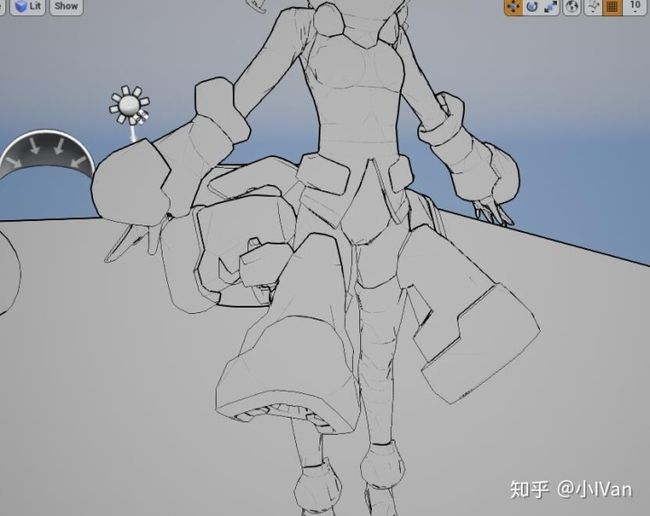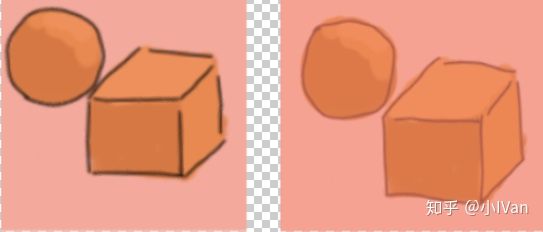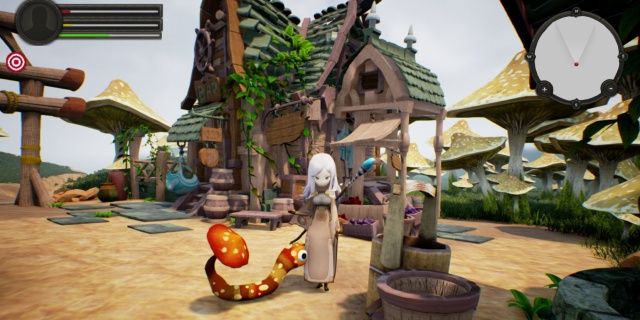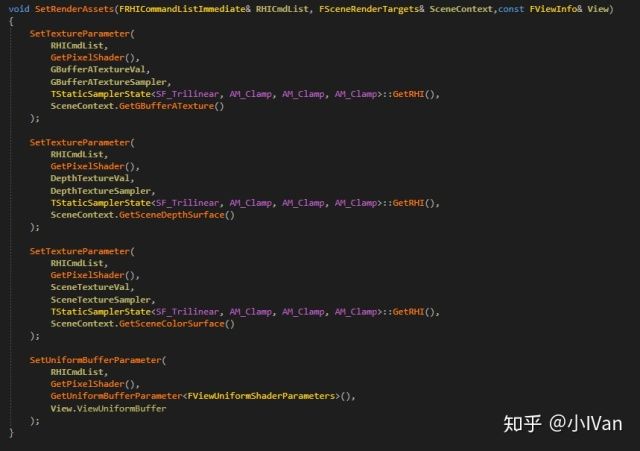虚幻4乱改引擎卡通渲染篇【第二卷:初步描边勾线】
MY BLOG DIRECTORY:
小IVan:专题概述及目录INTRODUCTION:
首先先感谢一下Alex Tsui的文章!
然后老规矩上效果:

我刻意用红线标明我的勾线等处理没有用后处理!为什么这么做呢,我后续说明。
下面是勾线:


这只是初步效果,以后我们会进一步完善优化。线的粗细是可以自己调的。那么下面就开始吧。
MAIN CONTENT:
首先需要说明一点的是,后处理也能做出很好的效果,但是有一个问题,请看下图:


(拿鼠标画的。字丑,画丑还请见谅)
仔细对比不难法线区别

现在的线是黑色的,如果线是其他颜色比如深褐色,如果还在后处理里面勾线其实是有问题的。而且后处理里很难处理一些比较复杂的东西。后面我们需要控制哪些物体勾线哪些不勾,哪些物体勾不同颜色的线,物体有些结构线很粗有些结构线很细。我们的目的是把虚幻改造成一个次世代卡通渲染引擎嘛,所以引擎应该原生自带勾线pass。下面我们就在上一节的基础上做进一步修改。
我们先新建两个文件
ToonOutline.usf放在引擎的shader目录的private下


ToonOutLineRendering.cpp放在Render目录下


然后generate一下就可以了。
在做修改前我们需要了解虚幻引擎才行,下面我们打开如下源码文件:
首先看到DefrredShadingRender.h和DefrredShadingRender.cpp两个,这两个便是控制我们渲染的主要函数了。场景渲染的DrawCall大都是在这里发生的。我们在DefrredShadingRendering.h中加入我们的渲染pass函数:

然后来到DefrredShadingRender.cpp里找到Render主函数

然后我们在Render函数中加入我们这个卡通勾线渲染pass函数的调用

可以看到我们可以控制我们的pass在任意渲染pass之前还是之后,这里我们选择在画雾之前绘制我们的勾线。
完成这一步之后自然是要对我们的RenderToonOutLine渲染pass函数进行完善啦。来到我们的ToonOutLineRendering.cpp文件,我们敲出我们的代码框架:
#include "DeferredShadingRenderer.h"
#include "AtmosphereRendering.h"
#include "ScenePrivate.h"
#include "Engine/TextureCube.h"
#include "PipelineStateCache.h"
#include "SceneView.h"
DECLARE_GPU_STAT(ToonOutLine);
class FToonOutLineVS : public FGlobalShader
{
DECLARE_SHADER_TYPE(FToonOutLineVS, Global);
public:
FToonOutLineVS(){}
FToonOutLineVS(const ShaderMetaType::CompiledShaderInitializerType& Initializer) :
FGlobalShader(Initializer)
{
//这里做绑定
}
static bool ShouldCompilePermutation(const FGlobalShaderPermutationParameters& Parameters)
{
return IsFeatureLevelSupported(Parameters.Platform, ERHIFeatureLevel::SM4);
}
static void ModifyCompilationEnvironment(const FGlobalShaderPermutationParameters& Parameters, FShaderCompilerEnvironment& OutEnvironment)
{
}
virtual bool Serialize(FArchive& Ar) override
{
bool bShaderHasOutdatedParameters = FGlobalShader::Serialize(Ar);
return bShaderHasOutdatedParameters;
}
private:
//成员
};
IMPLEMENT_SHADER_TYPE(, FToonOutLineVS, TEXT("/Engine/Private/ToonOutline.usf"), TEXT("MainVS"), SF_Vertex);
class FToonOutLinePS : public FGlobalShader
{
DECLARE_SHADER_TYPE(FToonOutLinePS, Global);
public:
FToonOutLinePS() {}
FToonOutLinePS(const ShaderMetaType::CompiledShaderInitializerType& Initializer) :
FGlobalShader(Initializer)
{
//这里做绑定
}
static bool ShouldCompilePermutation(const FGlobalShaderPermutationParameters& Parameters)
{
return IsFeatureLevelSupported(Parameters.Platform, ERHIFeatureLevel::SM4);
}
static void ModifyCompilationEnvironment(const FGlobalShaderPermutationParameters& Parameters, FShaderCompilerEnvironment& OutEnvironment)
{
}
virtual bool Serialize(FArchive& Ar) override
{
bool bShaderHasOutdatedParameters = FGlobalShader::Serialize(Ar);
return bShaderHasOutdatedParameters;
}
void SetRenderAssets(FRHICommandListImmediate& RHICmdList, FSceneRenderTargets& SceneContext,const FViewInfo& View)
{
}
private:
};
IMPLEMENT_SHADER_TYPE(, FToonOutLinePS, TEXT("/Engine/Private/ToonOutline.usf"), TEXT("MainPS"), SF_Pixel);
struct FToonOutLineVertex
{
FVector4 Position;
FVector2D UV;
};
class FToonOutLineVertexDesc : public FRenderResource
{
public:
FVertexDeclarationRHIRef VertexDeclarationRHI;
// Destructor
virtual ~FToonOutLineVertexDesc() {}
virtual void InitRHI() override
{
FVertexDeclarationElementList Elements;
uint32 Stride = sizeof(FToonOutLineVertex);
Elements.Add(FVertexElement(0, STRUCT_OFFSET(FToonOutLineVertex, Position), VET_Float4, 0, Stride));
Elements.Add(FVertexElement(0, STRUCT_OFFSET(FToonOutLineVertex, UV), VET_Float2, 1, Stride));
VertexDeclarationRHI = RHICreateVertexDeclaration(Elements);
}
virtual void ReleaseRHI() override
{
VertexDeclarationRHI.SafeRelease();
}
};
TGlobalResource GToonOutLineVertexDesc;
void FDeferredShadingSceneRenderer::RenderToonOutLine(FRHICommandListImmediate& RHICmdList)
{
} 可以看到还是非常简单的,我们需要一个顶点着色器,一个像素着色器,一个顶点输入布局。
然后我们敲出我们的shader代码框架
#include "Common.ush"
void MainVS(
in float4 InPosition : ATTRIBUTE0,
in float2 InUV : ATTRIBUTE1,
out float2 OutUV : TEXCOORD0,
out float4 OutPosition : SV_POSITION
)
{
OutPosition = InPosition;
OutUV = InUV;
}
void MainPS(
in float2 UV : TEXCOORD0,
out float4 OutColor : SV_Target0
)
{
OutColor = float4(1, 1, 1, 1);
}我们完成了一个像素着色器和一个顶点着色器。
这部分的思路和我之前的一篇修改虚幻4Pass的文章类似。
小IVan:虚幻4渲染编程(Shader篇)【第九卷:自定义渲染管线】
我们把Render函数补全一下:
void FDeferredShadingSceneRenderer::RenderToonOutLine(FRHICommandListImmediate& RHICmdList)
{
// Draw grid.
//uint32 PrimitiveCount = 2;
//RHICmdList.DrawPrimitive(PT_TriangleList, 0, PrimitiveCount, 1);
FToonOutLineVertex Vertices[4];
Vertices[0].Position.Set(-1.0f, 1.0f, 0, 1.0f);
Vertices[1].Position.Set(1.0f, 1.0f, 0, 1.0f);
Vertices[2].Position.Set(-1.0f, -1.0f, 0, 1.0f);
Vertices[3].Position.Set(1.0f, -1.0f, 0, 1.0f);
Vertices[0].UV = FVector2D(0.0f, 0.0f);
Vertices[1].UV = FVector2D(1.0f, 0.0f);
Vertices[2].UV = FVector2D(0.0f, 1.0f);
Vertices[3].UV = FVector2D(1.0f, 1.0f);
static const uint16 Indices[6] =
{
0, 1, 2,
2, 1, 3
};
FSceneRenderTargets& SceneContext = FSceneRenderTargets::Get(RHICmdList);
SceneContext.BeginRenderingSceneColor(RHICmdList, ESimpleRenderTargetMode::EExistingColorAndDepth, FExclusiveDepthStencil::DepthRead_StencilWrite, true);
FGraphicsPipelineStateInitializer GraphicsPSOInit;
RHICmdList.ApplyCachedRenderTargets(GraphicsPSOInit);
for (int32 ViewIndex = 0; ViewIndex < Views.Num(); ViewIndex++)
{
const FViewInfo& View = Views[ViewIndex];
if (View.IsPerspectiveProjection() == false)
{
continue;
}
TShaderMapRef VertexShader(View.ShaderMap);
TShaderMapRef PixelShader(View.ShaderMap);
RHICmdList.SetViewport(View.ViewRect.Min.X, View.ViewRect.Min.Y, 0.0f, View.ViewRect.Max.X, View.ViewRect.Max.Y, 1.0f);
GraphicsPSOInit.RasterizerState = TStaticRasterizerState::GetRHI();
//GraphicsPSOInit.BlendState = TStaticBlendState::GetRHI();
GraphicsPSOInit.BlendState = TStaticBlendState::GetRHI();
GraphicsPSOInit.DepthStencilState = TStaticDepthStencilState::GetRHI();
GraphicsPSOInit.PrimitiveType = PT_TriangleList;
GraphicsPSOInit.BoundShaderState.VertexDeclarationRHI = GToonOutLineVertexDesc.VertexDeclarationRHI;
GraphicsPSOInit.BoundShaderState.VertexShaderRHI = GETSAFERHISHADER_VERTEX(*VertexShader);
GraphicsPSOInit.BoundShaderState.PixelShaderRHI = GETSAFERHISHADER_PIXEL(*PixelShader);
SetGraphicsPipelineState(RHICmdList, GraphicsPSOInit);
PixelShader->SetRenderAssets(RHICmdList, SceneContext, View);
// Draw a quad covering the view.
DrawIndexedPrimitiveUP(
RHICmdList,
PT_TriangleList,
0,
ARRAY_COUNT(Vertices),
2,
Indices,
sizeof(Indices[0]),
Vertices,
sizeof(Vertices[0])
);
}
} 代码的开始我们需要注意屏幕空间面片的扰序和UV,unreal是dx的所以需要注意一下和gl的区别。

上面的代码里面有个SetRenderAsset函数,它是像素着色器的,我们去像素着色器中实现它


我们在这个函数中做了一些事情,传了GBuffer的一些数据进我们的pass,然后还传了一个UniformBuffer:View
我们先放下狂敲代码的双手,来看看这个ViewUniformBuffer。
我们找到SceneView的头文件和源文件

上图就是这个庞大的常量缓冲了,里面存了大量我们渲染的时候需要的数据。
我们不是还需要传GBuffer么,我们可以找到SceneRenderTarget头文件和源文件

这里存了我们想要的各种buffer资源。
然后是我们在pixelshader里勾线了:
我们用处理图像的办法,对场景深度图和场景世界法线图分别进行卷积操作,

(这里别在意代码完整性,我只是截出关键部分,后面我会给出全部修改)
下面是我对引擎完整的修改


ToonOutline.usf
#include "Common.ush"
void MainVS(
in float4 InPosition : ATTRIBUTE0,
in float2 InUV : ATTRIBUTE1,
out float2 OutUV : TEXCOORD0,
out float4 OutPosition : SV_POSITION
)
{
OutPosition = InPosition;
OutUV = InUV;
}
Texture2D GBufferATexture;
SamplerState GBufferATextureSampler;
Texture2D DepthTexture;
SamplerState DepthTextureSampler;
Texture2D SceneTexture;
SamplerState SceneTextureSampler;
void MainPS(
in float2 UV : TEXCOORD0,
out float4 OutColor : SV_Target0
)
{
OutColor = float4(1.0f, 1.0f, 1.0f, 1.0f);
float2 PixelSize = View.ViewSizeAndInvSize.zw;
float3 linecolor = float3(0.0f, 0.0f, 0.0f);
float4 SceneColor = Texture2DSampleLevel(SceneTexture, SceneTextureSampler, UV, 0);
float2 uvc = UV;
float2 uvu = UV + float2(0.0f, -1.0f) * PixelSize;
float2 uvn = UV + float2(0.0f, 1.0f) * PixelSize;
float2 uvl = UV + float2(-1.0f, 0.0f) * PixelSize;
float2 uvr = UV + float2(1.0f, 0.0f) * PixelSize;
float dc = ConvertFromDeviceZ(Texture2DSampleLevel(DepthTexture, DepthTextureSampler, uvc, 0).r);
float du = ConvertFromDeviceZ(Texture2DSampleLevel(DepthTexture, DepthTextureSampler, uvu, 0).r);
float dn = ConvertFromDeviceZ(Texture2DSampleLevel(DepthTexture, DepthTextureSampler, uvn, 0).r);
float dl = ConvertFromDeviceZ(Texture2DSampleLevel(DepthTexture, DepthTextureSampler, uvl, 0).r);
float dr = ConvertFromDeviceZ(Texture2DSampleLevel(DepthTexture, DepthTextureSampler, uvr, 0).r);
float dcSdu = dc - du;
float dcSdn = dc - dn;
float dcSdl = dc - dl;
float dcSdr = dc - dr;
float D = pow((dcSdu + dcSdn + dcSdr + dcSdl) * 0.5f, 3.0f);
float3 nc = Texture2DSampleLevel(GBufferATexture, GBufferATextureSampler, uvc, 0).rgb;
float3 nu = Texture2DSampleLevel(GBufferATexture, GBufferATextureSampler, uvu, 0).rgb;
float3 nn = Texture2DSampleLevel(GBufferATexture, GBufferATextureSampler, uvn, 0).rgb;
float3 nl = Texture2DSampleLevel(GBufferATexture, GBufferATextureSampler, uvl, 0).rgb;
float3 nr = Texture2DSampleLevel(GBufferATexture, GBufferATextureSampler, uvr, 0).rgb;
float3 ncSnu = nc - nu;
float3 ncSnn = nc - nn;
float3 ncSnl = nc - nl;
float3 ncSnr = nc - nr;
float3 N = ncSnu + ncSnn + ncSnl + ncSnr;
float na = N.x + N.y + N.z;
float nb = pow(na * 10.0f, 5.0f);
float a = saturate(max(nb, D));
OutColor.rgb = lerp(float3(100.0f, 100.0f, 100.0f), float3(0, 0, 0), a);
//float4(GBufferATexture.Sample(GBufferATextureSampler, UV.xy).rgb, 1.0f);
//OutColor = float4(DepthTexture.Sample(DepthTextureSampler, UV.xy).rgb, 1.0f);
//OutColor = float4(1, 1, 1, 1);
}ToonOutLineRendering.cpp
#include "DeferredShadingRenderer.h"
#include "AtmosphereRendering.h"
#include "ScenePrivate.h"
#include "Engine/TextureCube.h"
#include "PipelineStateCache.h"
#include "SceneView.h"
DECLARE_GPU_STAT(ToonOutLine);
class FToonOutLineVS : public FGlobalShader
{
DECLARE_SHADER_TYPE(FToonOutLineVS, Global);
public:
FToonOutLineVS(){}
FToonOutLineVS(const ShaderMetaType::CompiledShaderInitializerType& Initializer) :
FGlobalShader(Initializer)
{
//这里做绑定
}
static bool ShouldCompilePermutation(const FGlobalShaderPermutationParameters& Parameters)
{
return IsFeatureLevelSupported(Parameters.Platform, ERHIFeatureLevel::SM4);
}
static void ModifyCompilationEnvironment(const FGlobalShaderPermutationParameters& Parameters, FShaderCompilerEnvironment& OutEnvironment)
{
}
virtual bool Serialize(FArchive& Ar) override
{
bool bShaderHasOutdatedParameters = FGlobalShader::Serialize(Ar);
return bShaderHasOutdatedParameters;
}
private:
//成员
};
IMPLEMENT_SHADER_TYPE(, FToonOutLineVS, TEXT("/Engine/Private/ToonOutline.usf"), TEXT("MainVS"), SF_Vertex);
class FToonOutLinePS : public FGlobalShader
{
DECLARE_SHADER_TYPE(FToonOutLinePS, Global);
public:
FToonOutLinePS() {}
FToonOutLinePS(const ShaderMetaType::CompiledShaderInitializerType& Initializer) :
FGlobalShader(Initializer)
{
//这里做绑定
GBufferATextureVal.Bind(Initializer.ParameterMap, TEXT("GBufferATexture"));
GBufferATextureSampler.Bind(Initializer.ParameterMap, TEXT("GBufferATextureSampler"));
DepthTextureVal.Bind(Initializer.ParameterMap, TEXT("DepthTexture"));
DepthTextureSampler.Bind(Initializer.ParameterMap, TEXT("DepthTextureSampler"));
SceneTextureVal.Bind(Initializer.ParameterMap, TEXT("SceneTexture"));
SceneTextureSampler.Bind(Initializer.ParameterMap, TEXT("SceneTextureSampler"));
}
static bool ShouldCompilePermutation(const FGlobalShaderPermutationParameters& Parameters)
{
return IsFeatureLevelSupported(Parameters.Platform, ERHIFeatureLevel::SM4);
}
static void ModifyCompilationEnvironment(const FGlobalShaderPermutationParameters& Parameters, FShaderCompilerEnvironment& OutEnvironment)
{
}
virtual bool Serialize(FArchive& Ar) override
{
bool bShaderHasOutdatedParameters = FGlobalShader::Serialize(Ar);
Ar << GBufferATextureVal << GBufferATextureSampler << DepthTextureVal << DepthTextureSampler << SceneTextureVal << SceneTextureSampler;
return bShaderHasOutdatedParameters;
}
void SetRenderAssets(FRHICommandListImmediate& RHICmdList, FSceneRenderTargets& SceneContext,const FViewInfo& View)
{
SetTextureParameter(
RHICmdList,
GetPixelShader(),
GBufferATextureVal,
GBufferATextureSampler,
TStaticSamplerState::GetRHI(),
SceneContext.GetGBufferATexture()
);
SetTextureParameter(
RHICmdList,
GetPixelShader(),
DepthTextureVal,
DepthTextureSampler,
TStaticSamplerState::GetRHI(),
SceneContext.GetSceneDepthSurface()
);
SetTextureParameter(
RHICmdList,
GetPixelShader(),
SceneTextureVal,
SceneTextureSampler,
TStaticSamplerState::GetRHI(),
SceneContext.GetSceneColorSurface()
);
SetUniformBufferParameter(
RHICmdList,
GetPixelShader(),
GetUniformBufferParameter(),
View.ViewUniformBuffer
);
}
private:
FShaderResourceParameter GBufferATextureVal;
FShaderResourceParameter GBufferATextureSampler;
FShaderResourceParameter DepthTextureVal;
FShaderResourceParameter DepthTextureSampler;
FShaderResourceParameter SceneTextureVal;
FShaderResourceParameter SceneTextureSampler;
};
IMPLEMENT_SHADER_TYPE(, FToonOutLinePS, TEXT("/Engine/Private/ToonOutline.usf"), TEXT("MainPS"), SF_Pixel);
struct FToonOutLineVertex
{
FVector4 Position;
FVector2D UV;
};
class FToonOutLineVertexDesc : public FRenderResource
{
public:
FVertexDeclarationRHIRef VertexDeclarationRHI;
// Destructor
virtual ~FToonOutLineVertexDesc() {}
virtual void InitRHI() override
{
FVertexDeclarationElementList Elements;
uint32 Stride = sizeof(FToonOutLineVertex);
Elements.Add(FVertexElement(0, STRUCT_OFFSET(FToonOutLineVertex, Position), VET_Float4, 0, Stride));
Elements.Add(FVertexElement(0, STRUCT_OFFSET(FToonOutLineVertex, UV), VET_Float2, 1, Stride));
VertexDeclarationRHI = RHICreateVertexDeclaration(Elements);
}
virtual void ReleaseRHI() override
{
VertexDeclarationRHI.SafeRelease();
}
};
TGlobalResource GToonOutLineVertexDesc;
void FDeferredShadingSceneRenderer::RenderToonOutLine(FRHICommandListImmediate& RHICmdList)
{
// Draw grid.
//uint32 PrimitiveCount = 2;
//RHICmdList.DrawPrimitive(PT_TriangleList, 0, PrimitiveCount, 1);
FToonOutLineVertex Vertices[4];
Vertices[0].Position.Set(-1.0f, 1.0f, 0, 1.0f);
Vertices[1].Position.Set(1.0f, 1.0f, 0, 1.0f);
Vertices[2].Position.Set(-1.0f, -1.0f, 0, 1.0f);
Vertices[3].Position.Set(1.0f, -1.0f, 0, 1.0f);
Vertices[0].UV = FVector2D(0.0f, 0.0f);
Vertices[1].UV = FVector2D(1.0f, 0.0f);
Vertices[2].UV = FVector2D(0.0f, 1.0f);
Vertices[3].UV = FVector2D(1.0f, 1.0f);
static const uint16 Indices[6] =
{
0, 1, 2,
2, 1, 3
};
FSceneRenderTargets& SceneContext = FSceneRenderTargets::Get(RHICmdList);
SceneContext.BeginRenderingSceneColor(RHICmdList, ESimpleRenderTargetMode::EExistingColorAndDepth, FExclusiveDepthStencil::DepthRead_StencilWrite, true);
FGraphicsPipelineStateInitializer GraphicsPSOInit;
RHICmdList.ApplyCachedRenderTargets(GraphicsPSOInit);
for (int32 ViewIndex = 0; ViewIndex < Views.Num(); ViewIndex++)
{
const FViewInfo& View = Views[ViewIndex];
if (View.IsPerspectiveProjection() == false)
{
continue;
}
TShaderMapRef VertexShader(View.ShaderMap);
TShaderMapRef PixelShader(View.ShaderMap);
RHICmdList.SetViewport(View.ViewRect.Min.X, View.ViewRect.Min.Y, 0.0f, View.ViewRect.Max.X, View.ViewRect.Max.Y, 1.0f);
GraphicsPSOInit.RasterizerState = TStaticRasterizerState::GetRHI();
//GraphicsPSOInit.BlendState = TStaticBlendState::GetRHI();
GraphicsPSOInit.BlendState = TStaticBlendState::GetRHI();
GraphicsPSOInit.DepthStencilState = TStaticDepthStencilState::GetRHI();
GraphicsPSOInit.PrimitiveType = PT_TriangleList;
GraphicsPSOInit.BoundShaderState.VertexDeclarationRHI = GToonOutLineVertexDesc.VertexDeclarationRHI;
GraphicsPSOInit.BoundShaderState.VertexShaderRHI = GETSAFERHISHADER_VERTEX(*VertexShader);
GraphicsPSOInit.BoundShaderState.PixelShaderRHI = GETSAFERHISHADER_PIXEL(*PixelShader);
SetGraphicsPipelineState(RHICmdList, GraphicsPSOInit);
PixelShader->SetRenderAssets(RHICmdList, SceneContext, View);
// Draw a quad covering the view.
DrawIndexedPrimitiveUP(
RHICmdList,
PT_TriangleList,
0,
ARRAY_COUNT(Vertices),
2,
Indices,
sizeof(Indices[0]),
Vertices,
sizeof(Vertices[0])
);
}
} 

SUMMARY AND OUTLOOK:
至此我们完成了初步勾线和卡通阴影,下一步我们要完成更进一步的控制。Enjoy it!
NEXT:
YivanLee:虚幻4乱改引擎卡通渲染篇【第三卷:次世代漫画のレンダリングの最初の試み】